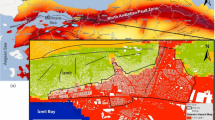Abstract
Natural catastrophes such as earthquakes can, in addition to causing loss of life, disrupt the urbanization process through the need for forced population redistribution and the modification of resource and environmental carrying capacity. The population carrying capacity (PCC) of an altered environment following an earthquake is a crucial determinant in the relocation of displaced persons. We use data adaptive methods to model the correlation between the physical environment and human population density in estimating PCC in areas affected by the 2008 Wenchuan earthquake. Comparing actual population distributions with ideal population distributions allows for the identification of villages where population exceeds PCC, or conversely, areas where the environment can support a higher population. Such a comparison can provide the basis for a relocation plan, a critical element of post-catastrophe policy-making.




Similar content being viewed by others
References
Christakos, G. (2010). Integrative problem-solving in a time of decadence. New York: Springer.
Fan, J. (2009). State planning for Wenchuan earthquake rebuilding—assessment of environmental and resource carrying capacity (in Chinese). Beijing: Science Press.
Fischer, M. M., & Nijkamp, P. (1999). Spatial dynamics of European integration: Regional and policy issues at the turn of the century. Berlin: Springer.
Gao, X. L., & Asami, Y. (2007). Influence of lot size and shape on redevelopment projects. Land Use Policy, 24, 212–222.
Haimes, Y. Y. (2008). Risk modeling, assessment, and management (3rd ed.). New York: Wiley.
Haining, R. (2003). Spatial data analysis: Theory and practice. Cambridge: Cambridge University Press.
Leung, Y., & Leung, K. S. (1993). An intelligent expert system shell for knowledge-based geographical information systems: 1. The tools. International Journal of Geographical Information Science, 7, 189–199.
Li, X., & Liu, X. P. (2007). Case-based cellular automaton for simulating urban development in a large complex region (in Chinese). Acta Geographica Sinica, 62, 1097–1109.
Li, L. F., Wang, J. F., Cao, Z. D., Feng, X. L., Zhang, L. L., & Zhong, E. S. (2008). An information-fusion method to regionalize spatial heterogeneity for improving the accuracy of spatial sampling estimation (in Chinese). Stochastic Environmental Research and Risk Assessment, 22, 689–704.
Liao, Y. L., Wang, J. F., Guo, Y. Q., & Zheng, X. Y. (2010b). Risk assessment of human neural tube defects using a Bayesian belief network. Stochastic Environmental Research and Risk Assessment, 24, 93–100.
Liao, Y. L., Wang, J. F., & Meng, B. (2010a). GP, GA and GIS for mapping population distribution. International Journal of Geographical Information Sciences, 24, 47–67.
Marston, R. A. (2008). Land, life, and environmental change in mountains. Annals of the Association of American Geographers, 98, 507–520.
Parsons, T., Chen, J., & Eric, K. (2008). Stress changes from the 2008 Wenchuan earthquake and increased hazard in the Sichuan basin. Nature. doi:10.1038/nature07177.
Puleston, C. O., & Tuljapurkar, S. (2008). Population and prehistory II: Space-limited human populations in constant environments. Theoretical Population Biology, 74, 147–160.
Wang, J. F. (1993). Methodology for assessing natural disaster risk in China (in Chinese). Beijing: China Science & Technology Press.
Wang, J. F., Cheng, G. D., Gao, Y. G., Long, A. H., Li, X., & Xu, Z. M. (2008a). Optimal water allocation in arid and semi-arid areas. Water Resources Management, 22, 239–258.
Wang, J. F., Haining, R., & Cao, Z. D. (2010). Sample surveying to estimate the mean of a heterogeneous surface: Reducing the error variance through zoning. International Journal of Geographical Information Science, 24(4), 523–543.
Wang, J. F., & Li, L. F. (2008). Improving tsunami warning systems with remote sensing and geographical information system input. Risk Analysis, 28(6), 1653–1668.
Wang, J. F., Wise, S., & Haining, R. (1997). An integrated regionalization of earthquake, flood and drought hazards in China. Transactions in GIS, 2, 25–44.
Wang, K. Y., Chen, T., Wang, L. Y., & Yuan, X. (2008b). Harmonious development model of urban and rural integration in quasi-urbanization areas (in Chinese). Scientia Geographica Sinica, 28, 173–178.
Zhang, W. Z., Liu, W., & Meng, B. (2005). On location advantage value of residential environment in the urban and suburban areas of Beijing (in Chinese). Acta Geographica Sinica, 60, 115–121.
Acknowledgments
This study was supported by the NSFC (41023010), CAS (XDA05090102), the MOST (2009ZX10004-201, 2008BA156B02, 2006BAK01A13).
Author information
Authors and Affiliations
Corresponding authors
Rights and permissions
About this article
Cite this article
Wang, JF., Liao, YL., Wang, JJ. et al. Adaptive modeling of the human-environment relationship applied to estimation of the population carrying capacity in an earthquake zone. Popul Environ 33, 233–242 (2012). https://doi.org/10.1007/s11111-011-0143-3
Published:
Issue Date:
DOI: https://doi.org/10.1007/s11111-011-0143-3




